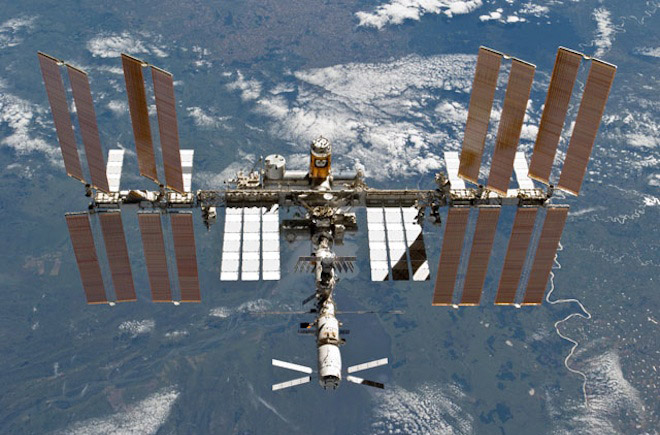An unmanned private spacecraft currently orbiting Earth successfully completed a historic flyby of the International Space Station early Thursday morning, a necessary step toward the goal of docking the spacecraft to the station on Friday, becoming the first-ever commercial vessel in history to complete the tricky procedure.
SpaceX’s Dragon capsule, a reusable spacecraft designed and built by the Hawthorne, California-based company, fired some of its 18 thrusters and flew about a mile and a half underneath the International Space Station at around 2:30 a.m. ET, giving the station’s current crew of six astronauts (three Russian, two American and one European) an unparalleled view of the commercial space vessel flying over Earth, its strobe light on to signal to the station.
Check out the following video of the flyby from the view of the International Space Station here, via NASA. Another video was posted on YouTube.
“The last time we saw an American spacecraft from this standpoint was almost a year ago, as Space Shuttle Atlantis bid farewell to the Space Station during STS-135, the final space shuttle mission,” noted a NASA mission control narrating the video.
Here’s a photo of the Dragon flyby from the space station’s view. The tiny spec in the lower left corner is the Dragon, orbiting over a sea of clouds on Earth.

The craft also successfully passed two additional key tests on the flyby: Demonstrating its GPS system and its communication link to the International Space Station, also both prerequisites for the docking to get the go ahead from NASA on Friday, currently scheduled to begin at 2 a.m. The event will be live-streamed on the NASA TV website.
“Today went very close to how we had trained for it,” said Holly Ridings, a NASA flight director overseeing the mission, in a televised press conference following the flyby, “Everything held up.”
But, as she cautioned, the docking procedure remained the most challenging aspect of the mission. So far, docking missions to the International Space Station have only been completed by five governments, those of the United States, Russia, Japan and the European Union.
SpaceX is also going the extra (hundred or so) miles of ferrying just over 1,000 pounds of cargo — food, water and clothing — to the station, and expects to bring back old equipment and junk on its return mission to Earth.
“There are a lot of really new things that teams need to perform and the vehicles, frankly, need to perform,” Ridings said.
SpaceX CEO and lead designer Elon Musk, for his part, was elated at the success of the Dragon mission so far, tweeting that he almost missed an important phone call congratulating him and the rest of SpaceX’s 1,800 some employees on their historic mission.
“The President just called to say congrats. Caller ID was blocked, so at first I thought it was a telemarketer :),” Musk tweeted.
If the docking procedure goes ahead as planned, the Dragon will remain docked to the station for 11 days. The current timetable calls for the astronauts to open Dragon’s hatch and begin transferring cargo over on Saturday. Then, the craft will remain docked and further tests will be conducted for another five days, before the Dragon disembarks from the station and heads for Earth on May 31. It’s set to plunk down in the Pacific Ocean and be retrieved by SpaceX later that day, to be re-used on further missions.
Even if the docking doesn’t occur on Friday, the Dragon can remain “parked,” or anchored to the space station by a robotic arm, overnight, and the docking re-attempted again on Saturday, Ridings said.
In either case, SpaceX has already made history in just attempting the mission and successfully getting its rocket off the ground on May 22, after several delays an aborted attempt a day prior.
The company aims to become NASA’s de-facto mode of transportation to get astronauts and crew into low-earth orbit, replacing the Space Shuttle, retired in the summer of 2011, and the current method of transport, the Russian Soyuz vessels. SpaceX has won a $1.6 billion contract from NASA for 12 flights to the station. This would be its first.






